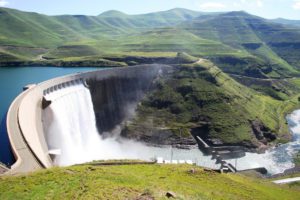The Department of Water and Sanitation (DWS) has called on mining houses that have not registered their dams on the department’s database to submit their information in order to ensure compliance with dam safety regulations.
The department is currently updating the database of all tailings or mine residue deposit dams in the country that meet the requirements to be classified as “Dams with a Safety Risk” and called on mines to register their dams as required and submit their information. The department’s Dam Safety Regulation Director, Wally Ramokopa, said tailing dams are dams that are used to store water and waste that come as by-products from the mining processes. “Dams with a safety risk are those with a minimum height of five metres and able to store more than 50 000 cubic metres of water or water containing substance. The information will be used to update the register and also to monitor these dams as required by the National Water Act and the Dam Safety Regulations published in Government Notice R. 139 of 24 February 2012. “The department, through the directorate responsible for Dam Safety Regulations, is intensifying regulations on the safety of tailings/mine residue deposit dams across the country to ensure that these storage facilities are regulated, with a view of averting another undesirable occurrence, such as Jagersfontein disaster which occurred in the Free State on 11 September 2022, resulting in loss of lives and properties,” Ramokopa said. Ramokopa said it was important to provide the correct information in order to ensure the dams are registered and compliant, and further advised that for the information to be compiled by a registered engineering professional with knowledge of dams and/or tailings storage facilities.Dams with a safety risk is defined in section 117(c) (i) of the National Water Act as follows: any dam which can contain, store or dam more than 50 000 cubic metres of water, whether that water contains any substance or not, and which has a wall of a vertical height of more than five metres, measured as the vertical difference between the lowest downstream ground elevation on the outside of the dam wall and the non-overspill crest level or the general top level of the dam wall.
He said the department will soon execute random inspections to verify the correctness of the information and the existence of the dam(s), and collaborate with the Department of Mineral Resources and Energy (DMRE). “DWS has engaged the DMRE in order to get the data of mining houses and as a result correspondence has been sent to at least 337 tailings dams so that they can be classified as dams with a safety risk should they meet the requirements as stated, and encourage those mining houses that have not disclosed to DMRE ownership of tailing dams to register with the department,” Ramokopa said. As the custodian of water resources in the country, DWS is empowered by the National Water Act (Act 36 of 1998) to regulate dams so as to improve the safety of new and existing dams with a safety risk and to reduce the potential for harm to the public, damage to property or to resource quality. Section 120 in the National Water Act (NWA) requires an owner of a dam with a safety risk to register the dam within 120 days after the date on which the dam meets the requirements to be classified as a dam with a safety risk as defined in Section 117 of NWA.







